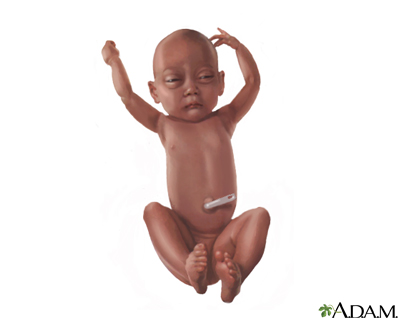

  |
Low birth weight refers to infants who weigh less than 5.5 pounds at birth. Most normal babies weigh 5.5 pounds by 37 weeks of gestation. Intrauterine growth restriction refers to delayed growth within the uterus, which then leads to low birth weight. Some babies are just small and happen to weigh less than 5.5 pounds at birth. Though this is considered low birth weight, in these cases, it is not abnormal or a cause for concern.

Low birth weight may be suspected before delivery if the size of the mother's uterus is small, or if a small fetus is shown by ultrasound. The fetus may appear symmetrically small, or have a head that is of normal size for gestational age but an unusually small abdomen. Although the overall size of the fetus or infant is small, the organ systems are appropriately mature for gestational age. If the mother is small, it may be normal for her to have a small fetus.
Several factors can cause delayed growth of a fetus. Babies with congenital anomalies or chromosomal abnormalities are often associated with low birth weights. Sometimes problems with the placenta can prevent it from providing adequate oxygen and nutrients to the fetus. Infections during pregnancy that affect the fetus, such as rubella, cytomegalovirus, toxoplasmosis, and syphilis, may also affect the baby's birth weight. Risk factors in the mother that may contribute to low birth weight include multiple pregnancies, previous low birth-weight infants, poor nutrition, heart disease or hypertension, smoking, drug addiction, alcohol abuse, lead exposure, and insufficient prenatal care. Low birth weight is more common in first-time pregnancies and among pregnant women under the age of 17 and over the age of 35.
Prenatal care is very important since few women carrying infants with delayed growth experience any symptoms. The most common symptom is simply a feeling that the baby is not as big as it should be. Because of this lack of symptoms, your health care provider should carefully measure your abdomen during each prenatal visit. If the measurements do not increase sufficiently over time, a follow-up exam will most likely include an ultrasound. The ultrasound can determine more precisely the gestational age of your baby and whether or not there is intrauterine growth restriction.
Low birth rate is also determined when your newborn is examined after delivery. If your baby's weight and length fall below the 10th percentile for his age, then he is considered to be low birth weight.
While there is no specific treatment, it is very important to maintain adequate nutrition during pregnancy for you and the fetus, and for your infant once he is born. In some cases, risk factors that may lead to low birth weight can be identified early on in the pregnancy and be reduced or eliminated through behavioral changes and treatment of chronic conditions. Most low birth-weight infants eventually catch up with the growth of other babies their age somewhere between the 18th and 24th month.
A number of complications may occur if your infant has experienced intrauterine growth restriction. A lack of oxygen during the birthing process, called birth asphyxia, may occur if the growth restriction is caused by problems with the placenta. Meconium aspiration (aspiration of amniotic fluid that is contaminated with the infant's first stool) may occur as a result of stress during delivery. There may also be low blood glucose levels during the first hours or days of life.
It’s hard for a mother to tell if she’s carrying a smaller-than-normal fetus, particularly it’s your first pregnancy. Nevertheless, call your health care provider if you are pregnant and your baby seems very small. You should also call if your infant or child does not seem to be growing or developing at a standard rate.
Although there are no proven prevention strategies, there are a few things you can do to increase your chances of giving birth to a baby with healthy weight. Proper nutrition, adequate rest, and avoidance of cigarettes, drugs, and alcohol will contribute to the development of a healthier child.
Q: What's the difference between low birth weight and premature birth?
A: Low birth weight is often confused with premature birth. Low birthweight simply refers to a baby’s weight at birth, while premature birth refers to a birth occurring before 37 weeks. Measurements of low birth weight have been expanded to include very low birth weight for infants weighing less than 3.3 pounds, or 1,500 grams, and extremely low birth weight for infants weighing less than 2.2 pounds, or 1000 grams.
Q: If my first child had a low birth weight, should I be concerned about my next pregnancy?
A: If you had a low birth-weight baby in a previous pregnancy, your risk of having another is moderately increased. The risk, however, depends on the reasons for the previous low birth-weight pregnancy. Be sure to receive adequate prenatal care and discuss your concerns and your medical history with your health care provider.